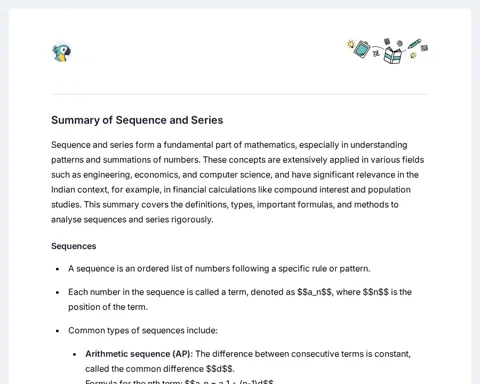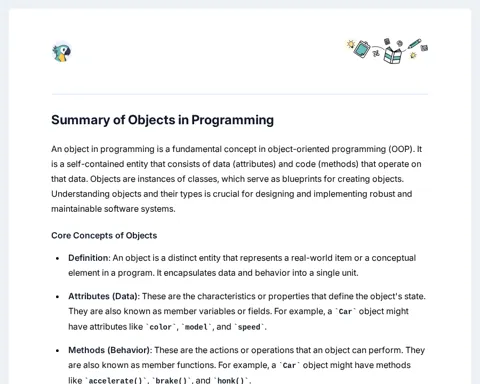Summary of Arithmetic Sequences
Arithmetic sequences are fundamental mathematical constructs where each term is derived by adding a constant difference to the previous term. These sequences provide a structured way to analyze patterns and model real-world phenomena involving consistent incremental changes. Understanding arithmetic sequences involves learning how to determine any term in the sequence and calculating the sum of a specific number of terms, which is crucial for applications in finance, engineering, and everyday problem-solving.
Definition and Characteristics of Arithmetic Sequences
- An arithmetic sequence is a list of numbers where the difference between consecutive terms is constant, called the common difference .
- The general form of an arithmetic sequence is: where is the first term.
- The common difference can be positive, negative, or zero, influencing whether the sequence increases, decreases, or remains constant.
Formula for the nth Term
- The nth term of an arithmetic sequence can be found using the formula:
- This formula allows direct calculation of any term in the sequence without listing all previous terms.
- Example: If and , the 10th term is .
Sum of the First n Terms
- The sum of the first terms of an arithmetic sequence is given by:
- Alternatively, using the nth term formula:
S\_n = \frac{n}{2} \[2a\_1 + (n - 1)d\] - This formula is useful for quickly finding the total of a sequence’s terms, such as total payments or cumulative distances.
Real-World Applications
- Financial Planning: Calculating total savings when depositing a fixed amount regularly with no interest.
- Construction: Estimating total materials needed when each new layer increases by a fixed amount.
- Sports: Tracking incremental improvements in training routines or scoring sequences.
- Transportation: Modeling distances traveled when speed increases or decreases by a constant rate.

Summary of Key Points
- Arithmetic sequences have a constant difference between terms.
- The nth term formula allows finding any term efficiently.
- The sum of the first n terms can be calculated with or S\_n = \frac{n}{2} \[2a\_1 + (n - 1)d\].
- These sequences have practical applications in everyday financial, engineering, and scientific contexts where regular incremental changes occur.
Mastering arithmetic sequences provides a foundation for understanding more complex mathematical series and real-world quantitative analysis.




